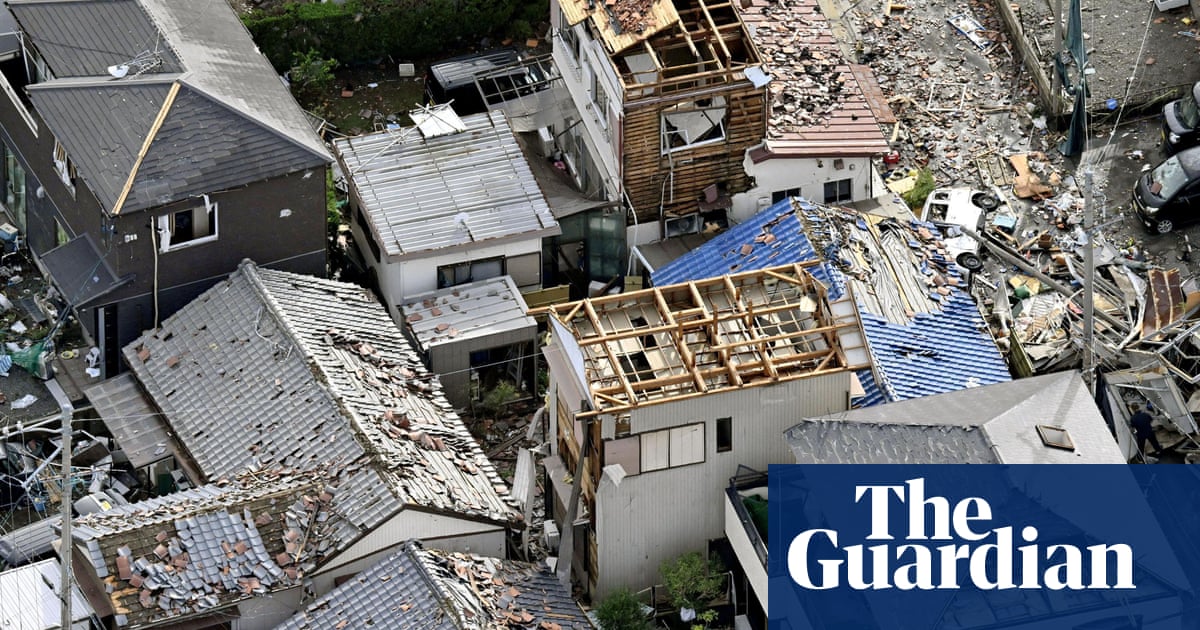The carbon footprint of the first 15 months of Israel’s war on Gaza will be greater than the annual planet-warming emissions of a hundred individual countries, exacerbating the global climate emergency on top of the huge civilian death toll, new research reveals.
A study shared exclusively with the Guardian found the long-term climate cost of destroying, clearing and rebuilding Gaza could top 31m tonnes of carbon dioxide equivalent (tCO2e). This is more than the combined 2023 annual greenhouse gases emitted by Costa Rica and Estonia, yet there is no obligation for states to report military emissions to the UN climate body.
Israel’s relentless bombardment, blockade and refusal to comply with international court rulings has underscored the asymmetry of each side’s war machine, as well as almost unconditional military, energy and diplomatic support Israel enjoys from allies including the US and UK.
Hamas bunker fuel and rockets account for about 3,000 tonnes of CO2e, the equivalent of just 0.2% of the total direct conflict emissions, while 50% were generated by the supply and use of weapons, tanks and other ordnance by the Israeli military (IDF), the study found.

Burning fossil fuels is causing climate chaos, with increasingly deadly and destructive extreme weather events forcing record numbers of people to migrate. The Gulf region is among the most vulnerable to extreme weather and slow-onset climate disasters including drought, desertification, extreme heat and erratic rainfall, as well as environmental degradation, food insecurity and water shortages.
The research, published by the Social Science Research Network, is part of a growing movement to hold states and businesses accountable for the climate and environmental costs of war and occupation, including the long-term impact damage to land, food and water sources, as well as post-conflict clean-up and reconstruction.
It is the third and most comprehensive analysis by a team of UK and US-based researchers into the climate cost of the first 15 months of conflict in which more than 53,000 Palestinians have been killed, in addition to widespread infrastructure damage and environmental catastrophe. It also provides the first, albeit partial, snapshot of the carbon cost of Israel’s other recent regional conflicts.
Overall, researchers estimate that the long-term climate cost of Israel’s military destruction in Gaza – and recent military exchanges with Yemen, Iran and Lebanon – is equivalent to charging 2.6bn smartphones or running 84 gas power plants for a year. This figure includes the estimated 557,359 tCO2e arising from the occupation-era construction of Hamas’s network of tunnels and Israel’s “iron wall” barrier.
The killing and environmental destruction of Gaza resumed when Israel unilaterally violated the ceasefire after just two months, but the findings could eventually help calculate claims for reparations.
“This updated research evidences the urgency to stop the escalating atrocities, and make sure that Israel and all states comply with international law, including the decisions from the ICC and the ICJ,” said Astrid Puentes, UN special rapporteur on the human right to a clean, healthy and sustainable environment. “Whether or not States agree on calling it a genocide, what we are facing is severely impacting all life in Gaza, and also threatening human rights in the region, and even globally, due to the aggravation of climate change.”
The study, currently under peer review by the journal One Earth, found:
-
Over 99% of the almost 1.89m tCO2e estimated to have been generated between the 7 October 2023 Hamas attack and the temporary ceasefire in January 2025 is attributed to Israel’s aerial bombardment and ground invasion of Gaza.
-
Almost 30% of greenhouse gases generated in that period came from the US sending 50,000 tonnes of weapons and other military supplies to Israel, mostly on cargo planes and ships from stockpiles in Europe. Another 20% is attributed to Israeli aircraft reconnaissance and bombing missions, tanks and fuel from other military vehicles, as well as CO2 generated by manufacturing and exploding the bombs and artillery.
-
Solar had generated as much as a quarter of Gaza’s electricity, representing one of the world’s highest shares, but most panels, and the territory’s only power plant, have been damaged or destroyed. Gaza’s limited access to electricity now mostly relies on diesel-guzzling generators that emitted just over 130,000 tons of greenhouse gases into the atmosphere, or 7% of the total conflict emissions.
-
More than 40% of the total emissions were generated by the estimated 70,000 aid trucks Israel allowed into the Gaza Strip – which the UN has condemned as grossly insufficient to meet the basic humanitarian needs of 2.2m displaced and starving Palestinians.
But the most significant climate cost will come from rebuilding Gaza, which Israel has reduced to an estimated 60m tonnes of toxic rubble.
The carbon cost of trucking out debris and then rebuilding 436,000 apartments, 700 schools, mosques, clinics, government offices and other buildings, as well as 5km of Gaza’s roads, will generate an estimated 29.4m tonnes eCO2. This is on a par with the entire 2023 emissions generated by Afghanistan.
The reconstruction figure is lower than previous estimates by the same research group due to a revision in the average size of apartment blocks.
“This report is a staggering and sobering reminder of the ecological and environmental cost of Israel’s genocidal campaign on the planet and its besieged people,” said Zena Agha, policy analyst for Palestinian policy network Al-Shabaka.
“But this is also the US, UK and EU’s war, all of which have provided seemingly limitless military resources to enable Israel to devastate the most densely populated place on the planet. This brings home the destabilising [regional] impact of the Israeli settler state and its inseparability from the western military-industrial complex.”
The war on Gaza has also provoked bloody regional tensions. The study found:
-
The Houthis in Yemen launched an estimated 400 rockets into Israel between October 2023 and January 2025, generating about 55 tCO2e. Israel’s aerial response generated almost 50 times more planet warming greenhouse gases. A previous study found that shipping emissions rose by an estimated 63% after the Houthis blocked the Red Sea corridor, forcing cargo ships to take longer routes.
-
A conservative estimate of emissions from two large-scale exchanges of missiles between Israel and Iran topped 5,000 tCO2e, with more than 80% down to Israel.
-
In Lebanon, more than 90% of the estimated 3,747 tCO2e generated by sporadic exchanges came from IDF bombs, with only 8% linked to Hezbollah rockets. The carbon cost of reconstructing 3,600 homes destroyed in southern Lebanon is almost as high as the annual emissions from the island of St Lucia.
The study is based on evolving methodology known as a scope 3+ framework which seeks to capture direct and indirect wartime emissions currently missing from global climate and conflict audits. This can include soil degradation, fires, infrastructure damage, displacement of people, aid, rerouting cargo ships and civil aviation.
Researchers relied on open-source information, media reports, and data from independent aid groups such as UN agencies. The true environmental costs are almost certainly higher given Israel’s media blockade, with data on razed farmland, desertification, remediation, and fires among other carbon-intense impacts hard to obtain.
“This conflict in Gaza shows that the numbers are substantial, greater than the entire greenhouse gas emissions of many entire countries, and must be included for accurate climate change and mitigation targets,” said Frederick Otu-Larbi, co-author, senior teaching associate at Lancaster Environment Centre and lecturer at University of Energy and Natural Resources in Ghana.
“Militaries need to reckon with the fact that their own national security and operational capacity is being compromised due to a changing climate of their own making,” said Ben Neimark, senior lecturer at Queen Mary University of London and study co-author.
Previous research has found that military emissions rise with spending and buildup.
Israel’s military budget surged in 2024 to $46.5bn – the largest increase in the world, according to the Stockholm International Peace Research Institute. Based on one methodology, Israel’s baseline military emissions last year – excluding direct conflict and reconstruction climate costs – rose to 6.5m tCO2e. This is more than the entire carbon footprint of Eritrea, a country of 3.5 million people.
Yet under current UN rules, reporting military emission data is voluntary and limited to fuel use, despite the fact the climate cost of the destruction of Gaza will be felt globally. The IDF, like most militaries worldwide, has never reported emission figures to the UN.
Hadeel Ikhmais, head of the climate change office at the Palestinian Environmental Quality Authority, said: “Wars not only kill people but also release toxic chemicals, destroy infrastructure, pollute soil, air and water resources and accelerate climate and environmental disasters. War also destroys climate adaptation and hinders environmental management. Not counting carbon emissions is a black hole in accountability that allows governments to get away from their environmental crimes.”

 3 months ago
138
3 months ago
138

















































